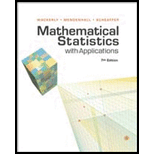
Concept explainers
Let Y be a random variable with
a Find the density function of U1 = 2Y − 1.
b Find the density function of U2 = 1 − 2Y.
c Find the density function of U3 = Y2.
d Find E(U1), E(U2), and E(U3) by using the derived density
e Find E(U1), E(U2), and E(U3) by the methods of Chapter 4.
a.
Find the density function for
Answer to Problem 1E
The density function for
Explanation of Solution
Calculation:
From the given information, the probability density function for Y is
The distribution function for Y is,
From the given information, the random variable
Consider the distribution function for
Limits for the random variable U1:
The range for the random variable Y is from 0 to 1 and
For Y= 0, the value of U1 is ̶ 1.
For
Hence, the range for the random variable U1 is from ̶ 1 to 1.
The probability density function for
b.
Find the density function for
Answer to Problem 1E
The density function for
Explanation of Solution
Calculation:
From the given information,
Consider the distribution function for
Limits for the random variable U2:
The range for the random variable Y is from 0 to 1 and
For Y= 0, the value of U2 is 1.
For
Hence, the range for the random variable U2 is from ̶ 1 to 1.
The probability density function for
c.
Find the density function for
Answer to Problem 1E
The density function for
Explanation of Solution
Calculation:
From the given information,
Consider the distribution function for
The probability density function for
d.
Find the value of
Find the value of
Find the value of
Answer to Problem 1E
The value of
The value of
The value of
Explanation of Solution
Calculation:
The density function for
Consider,
The density function for
Consider,
The density function for
Consider,
e.
Find the value of
Find the value of
Find the value of
Answer to Problem 1E
The value of
The value of
The value of
Explanation of Solution
Calculation:
Result:
Let X be the random variable, then
The density function for Y is
Consider,
Consider,
Want to see more full solutions like this?
Chapter 6 Solutions
Mathematical Statistics with Applications
- Let X and Y be independent random variables each having density function 2r fx (x) = 2 e * for x20 elsewhere Find: E (X+ Y)arrow_forwardA random variable, Y, has probability density function: -1< y<0 f(y) c+y 0 < y <1 otherwise a) Find the value of the constant, c. b) Find E(Y). c) Find Var(Y).arrow_forwardExercise 2: Let X be a random density variable f(x) = { e−2θx if x ≥ 0 0 else Find θ so that f is a probability density. Determine the distribution function F of the variable X. Calculate the expectation and variance of X. Let Y be the random variable defined by Y = θX. What is the law of Y?arrow_forward
 Calculus For The Life SciencesCalculusISBN:9780321964038Author:GREENWELL, Raymond N., RITCHEY, Nathan P., Lial, Margaret L.Publisher:Pearson Addison Wesley,
Calculus For The Life SciencesCalculusISBN:9780321964038Author:GREENWELL, Raymond N., RITCHEY, Nathan P., Lial, Margaret L.Publisher:Pearson Addison Wesley, Linear Algebra: A Modern IntroductionAlgebraISBN:9781285463247Author:David PoolePublisher:Cengage Learning
Linear Algebra: A Modern IntroductionAlgebraISBN:9781285463247Author:David PoolePublisher:Cengage Learning

